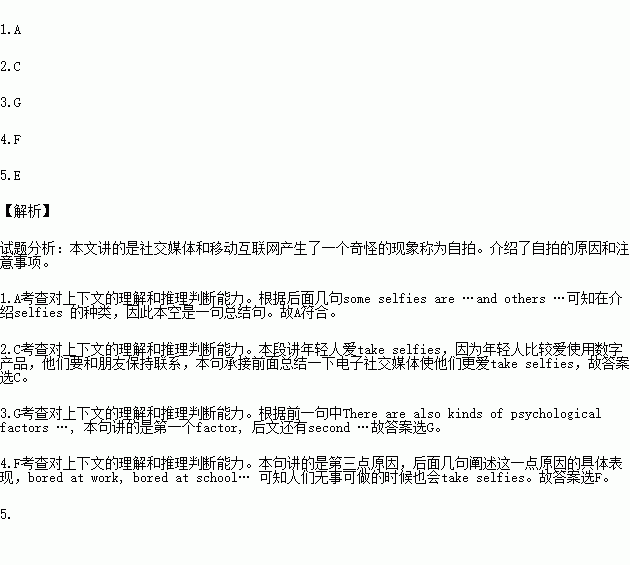题目内容
根据短文内容,从短文后的选项中选出能填入空白处的最佳选项。选项中有两项为多余选项。
Social media and the mobile web have given rise to a strange phenomenon(现象) called the selfie. It refers to a picture of yourself, usually shared on any social networking website.
1. Some selfies are extremely close-ups, and others show part of an arm held straight outward. A few of them even feature the subject standing in front of a bathroom mirror.
Everyone takes selfies, but the younger crowd seems to be especially involved in the trend. Young people are relatively heavier digital users. They are interested in staying connected to their friends. 2.
There are also kinds of psychological(心理学的) factors driving people to take a selfie and upload it to a social networking site. 3. A quick and easy way to attract others’ attention is to get “likes” and comment from friends. Secondly, it is human nature to show off your own great achievements. When you feel good about yourself or look good, it is far too easy to take out your phone and document it all through one or several selfies. 4. That is right. Sometimes people are bored at work, bored at school, bored at home and even bored on the toilet. Last but not the least, social media is about being social! If that means uploading as many selfies as possible, then so be it. It is fun, and it’s a cool way to sort of document of your own life.
Finally, there are things to be mindful of when you are posting. It’s easy to think you’re sharing a photo with a few people. 5. So don’t post anything online, selfie especially.
A. There are a lot of selfie styles.
B. The rise of selfies has become universal.
C. Social media, to some extent, is the driving force of their selfie activity.
D. The desire to take, post and get “likes” on selfies goes back to a biological behavior.
E. But the whole world of social media is public and every individual can get access to it.
F. There are also people who will take selfies because they have nothing else better to do.
G. The leading factor is that people want to get attention from as many people as possible.
 名师伴你成长课时同步学练测系列答案
名师伴你成长课时同步学练测系列答案
